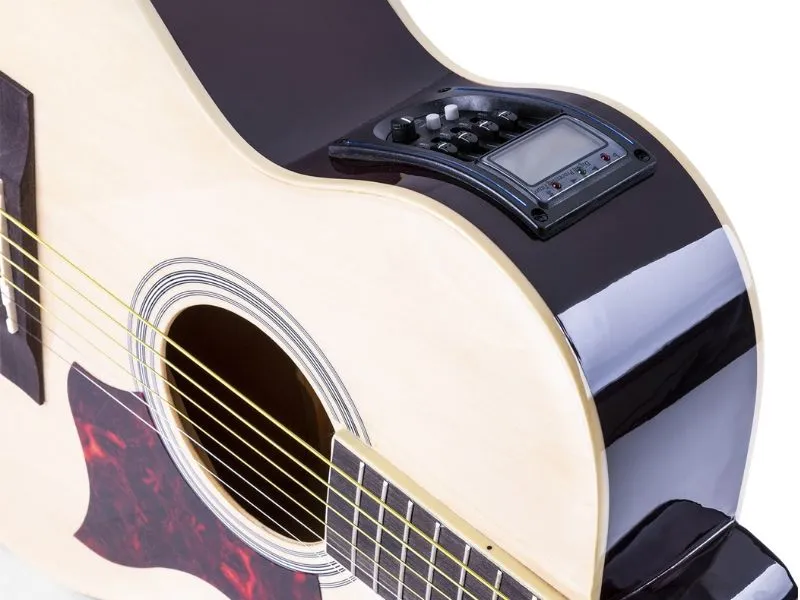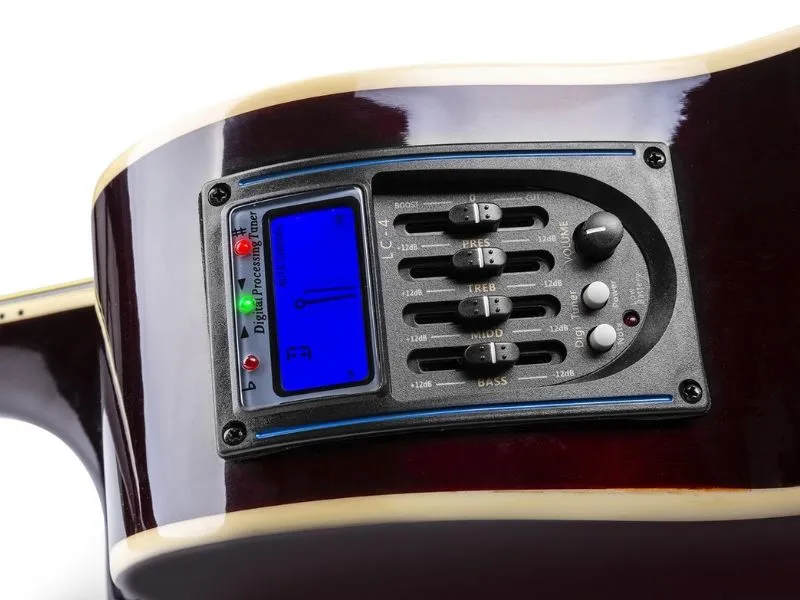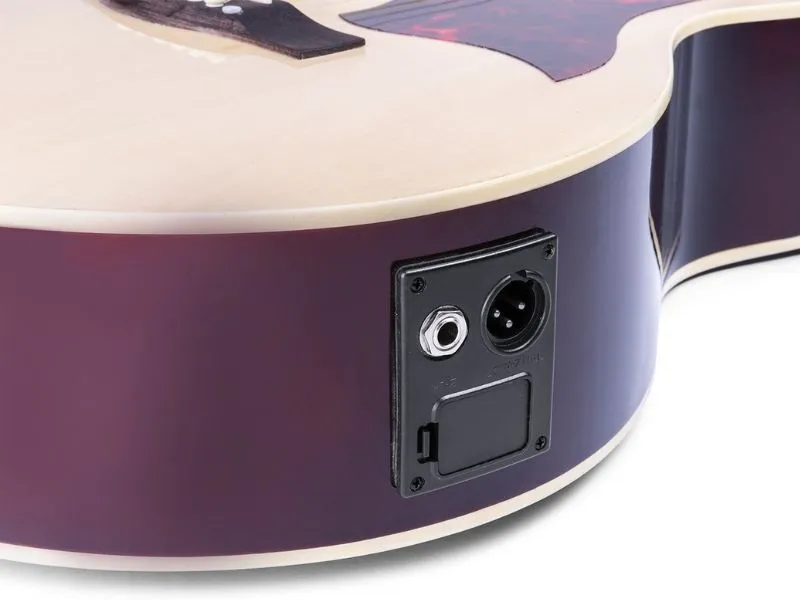What is an Electro-Acoustic Guitar?
Electro-Acoustic Guitars
In the world of stringed instruments, acoustic guitars hold a special place for their versatility, expressive capability, and the sheer variety of styles they embody. Among these styles, the electro-acoustic guitar presents a fascinating blend of traditional acoustic playability with modern electronic enhancement, making them of great interest to both novice and seasoned players. This hybrid instrument bridges the gap between the pure sound of an acoustic guitar and the amplified features of electric guitars, offering musicians a broad spectrum of sound possibilities.
In this article, we'll explore the intricacies of the electro-acoustic guitar, from its design and functionality to its application in various musical contexts. Whether you're contemplating your first guitar purchase or looking to expand your collection, understanding the electro-acoustic guitar's unique qualities will illuminate its role in today's music landscape.
What is an Acoustic Electric Guitar?
An acoustic-electric guitar, usually referred to as an electro-acoustic, marries the traditional acoustic guitar's resonant, natural sound with the versatility of electrical amplification. At its core, it remains a traditional acoustic guitar, crafted with a soundhole and a hollow body to produce sound acoustically.
The magic, however, lies in its built-in electronics, typically consisting of a pickup, a preamplifier (preamp), and an equaliser (EQ), which allow it to be connected to an amplifier or PA system without the need for a separate microphone.
This integration does not alter the guitar’s acoustical properties; unplugged, it sounds like a standard acoustic guitar. Yet, when plugged in, it provides greater control over the sound’s volume, tone, and balance, making it ideal for live performances and recording sessions. This versatility is a significant advantage, as it enables musicians to perform in various settings, from intimate gigs to large venues, without losing the guitar's natural tone.




Does an Electro-Acoustic need an Amplifier?
While an electro-acoustic guitar does not require an amplifier to produce sound—owing to its hollow body and soundhole, which allow it to function as a traditional acoustic guitar—the use of an amplifier unlocks its full potential. The built-in electronics are designed to capture and amplify the guitar's natural acoustic sound, providing an output signal which can be fed to an amplifier or PA mixer, and giving more control over the sound's characteristics, such as tone, volume, and balance.
For solo practice or small, intimate performances, an electro-acoustic guitar can be played unplugged. However, for larger venues, recording purposes, or situations where the guitar needs to cut through a mix of other instruments, an amplifier becomes essential. This flexibility makes the electro-acoustic guitar a versatile instrument, suitable for a wide range of musical genres and performance settings.
The choice of an acoustic amplifier, direct PA connection, or both, also influences the guitar’s final sound, with personal preference, budget constraints and convenience usually being the deciding factor.
What is the difference between an Acoustic and an Electro-Acoustic?
The primary difference between an acoustic and an electro-acoustic guitar lies in their ability to amplify sound. An acoustic guitar produces sound solely through its hollow body and soundhole, relying on the natural acoustics of its construction. An electro-acoustic guitar is built the same way, but incorporates a built-in pickup and electronics, allowing it to be connected to an amplifier or PA system for enhanced sound output.
This difference impacts not only the volume but also the versatility of the instrument. Electro-acoustic guitars offer musicians more control over their sound, with features like built-in signal preamps and EQ controls enabling adjustments to tone, volume, and a balanced output directly from the guitar for easy mixing desk connection. Some also include built-in tuners for convenience. This makes them particularly well-suited for live performances and recording situations where fine control over the sound is crucial.
Despite these differences, both types of guitars can produce the warm, rich tones associated with acoustic guitar music. The choice between them often comes down to the needs of the musician and the contexts in which they perform.


Read More...
Delving Deeper: Electro Acoustic Guitars
The electro-acoustic guitar represents a fusion of traditional craftsmanship and modern technology, offering a blend of natural acoustic sound with the benefits of electronic amplification. This hybrid nature provides several advantages but also introduces considerations unique to this type of guitar.
Electro-Acoustic Guitars - Pros and Cons
Pros:
-
Versatility: Electro-acoustic guitars are suitable for a wide range of musical genres and settings, from solo acoustic performances to amplified gigs and recordings.
Control: Built-in electronics offer direct control over sound output, allowing musicians to adjust volume, tone, and balance to suit their needs.
Convenience: The ability to plug directly into an amplifier or PA system eliminates the need for external microphones, simplifying setup and reducing feedback issues.
Cons:
-
Complexity: The addition of electronics can make the guitar more complex to use and maintain, potentially requiring additional knowledge and care. Preamp systems will require a power source (generally a 9-volt battery) which must be changed regularly to ensure the system operates correctly.
Cost: Generally, electro-acoustic guitars are more expensive than their purely acoustic counterparts, reflecting the added electronics and technology.
Features to Look For
-
Pickup Type: Different pickup types (such as piezo, magnetic, and microphone pickups) influence the amplified sound’s character. The pickup placement also has a large impact on the amplified sound available.
Piezo: A piezo pickup will often be in the form of a wire or conductive pad placed under the bridge saddle, which can make for a bright and harsh sound, especially if no tone controls are present. Some piezos are in the form of discs that are attached to the underside of the guitar's top surface. These will produce a much warmer output than a bridge unit, but can be lacking in detail.
Magnetic: Standard electric guitars use magnetic pickups, and there are custom versions available for acoustic guitars which will clamp across the open sound hole or be mounted to the guitar’s pickguard. They offer a good quality sound with natural balance due to their placement near the fretboard and over the soundhole where vibration is at its strongest.
Microphone: Some built-in preamps make use of a custom dynamic microphone, often on a small adjustable gooseneck that sits inside the guitar body. This can be used to capture the strings and some of the ambient sound of the guitar body, giving a full-bodied sound. They do add weight to the guitar which many players don't like.
Preamp or Direct Output: Electro-acoustics come in both passive and active variants. Generally, the lower-cost guitars will have a basic passive design, which will either be directly wired to an output socket, or via a volume pot. These put out a very weak instrument-level signal from the pickup, which must either be taken to a guitar amplifier or some form of signal boost (D.I. Box) to be suitable for connection to an audio mixer. The active type requires a battery to operate and will use a preamp circuit to boost the pickup signal to a level that's suitable for mixers and amplifiers. They will at minimum offer volume control, though usually will have tone-shaping control too.
Preamp Quality: A high-quality preamp can significantly enhance the guitar's sound, offering clearer amplification and more control over tone adjustments. These preamps can offer instrument-level and line-level outputs via a standard ¼” (6.35mm) jack socket, or will feature a balanced XLR connection for the best quality when going directly into a mixer.
Built-in Tuner: Many models also include a built-in tuner, some with simple LED indication and others with LCD displays. It’s a great convenience in any form.
EQ Controls: Adjustable equaliser controls allow for fine-tuning of the bass, mid, and treble frequencies, essential for shaping the guitar's sound in various environments, and helping to adjust out the harshness that the pickup can often add to the sound.
Ideal Uses
Electro-acoustic guitars excel in live performances, especially in settings where volume levels and sound clarity are paramount. They are also favoured in recording studios, where direct input recording can capture the guitar’s nuanced tones without the inconsistencies of microphone placement. Furthermore, these guitars are ideal for musicians who frequently switch between amplified and pure acoustic playing, providing the best of both worlds without the need for multiple instruments.
The Role Of The Preamp
An integral component of any good quality electro-acoustic guitar is its preamplifier. The preamp boosts the low output signal from the pickup, preparing it for further amplification and allowing for initial tone shaping. Depending on the design, the output will either be a standard unbalanced instrument level or a balanced mic level for easy connection directly to the channel of a mixer or desktop audio interface.
A quality preamp system can greatly affect the guitar's plugged-in sound, offering clarity, warmth, and fidelity that closely resembles its acoustic tone. It will balance out any harshness or unwanted overtones that certain pickup designs can introduce, and provide you with easy level adjustment during live performances and recordings.
Amplification: Necessary or Not?
An electro-acoustic guitar is just an enhanced acoustic and as such works perfectly fine unplugged, which is part of its huge appeal as it's not a compromise and can cover all bases. So no, you don’t need an amplifier, and even if you plan to record or play live it still isn't a necessity as most electro-acoustics can connect directly to a mixer and be played out through the PA system.
Should you wish to use one, amplifiers specifically designed for acoustic guitar use differ slightly from standard electric guitar amps in that they aren't intended to produce the extra drive and gain that's desired for playing rock. They will generally include a full EQ section with boosts for treble and midrange, and will often feature balanced XLR microphone inputs for people using room mics. Reverb will almost always be included, and sometimes other digital effects such as chorus or delay for both the guitar input and vocal channels. Professional acoustic performers will often use one even if the final mix is going into the main PA, as it gives them a greater range of tonal adjustments and effects.
Conclusions
The electro-acoustic guitar offers a compelling option for players seeking the authentic tones of an acoustic guitar with the added flexibility of amplification. By understanding the instrument's unique features and considerations, musicians can make informed decisions that align with their artistic needs and performance contexts, harnessing the full potential of this hybrid instrument to enhance their musical expression.


